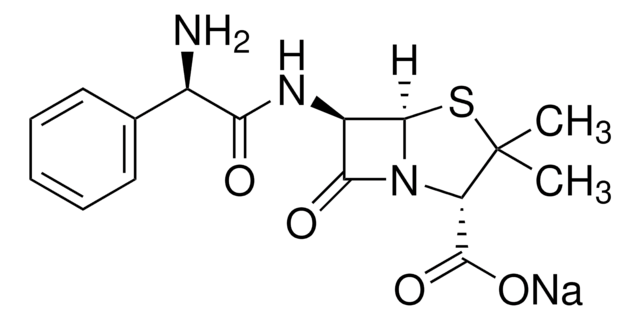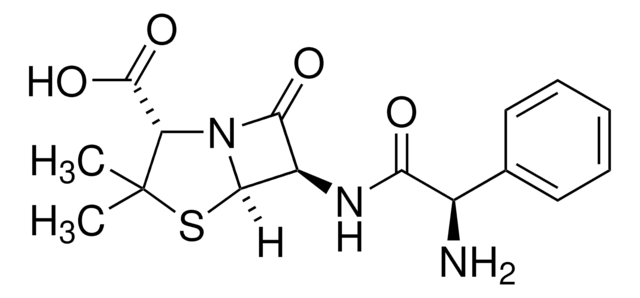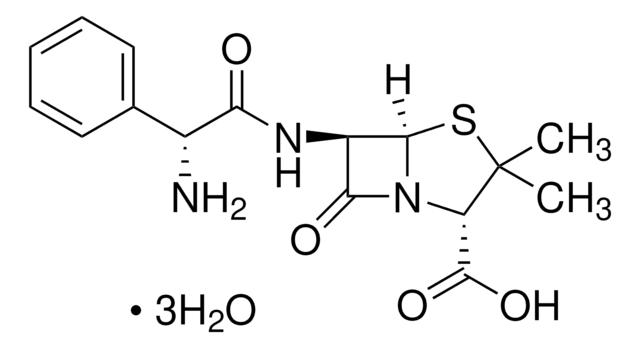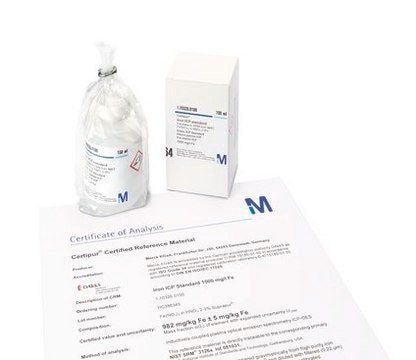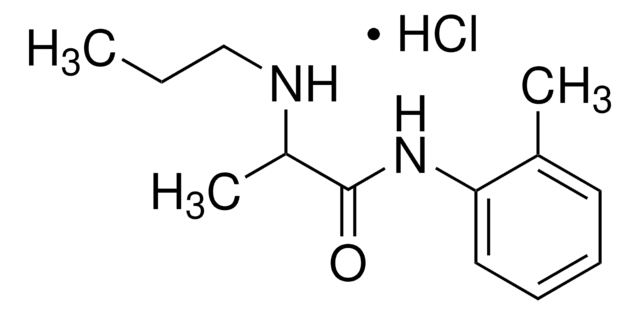1033203
USP
Ampicillin sodium
United States Pharmacopeia (USP) Reference Standard
Synonym(s):
Ampicillin sodium salt, D-(−)-α-Aminobenzylpenicillin sodium salt
About This Item
Recommended Products
grade
pharmaceutical primary standard
API family
ampicillin
manufacturer/tradename
USP
mp
215 °C (dec.) (lit.)
application(s)
pharmaceutical (small molecule)
format
neat
storage temp.
2-8°C
SMILES string
[Na+].CC1(C)SC2[C@H](NC(=O)[C@H](N)c3ccccc3)C(=O)N2[C@H]1C([O-])=O
InChI
1S/C16H19N3O4S.Na/c1-16(2)11(15(22)23)19-13(21)10(14(19)24-16)18-12(20)9(17)8-6-4-3-5-7-8;/h3-7,9-11,14H,17H2,1-2H3,(H,18,20)(H,22,23);/q;+1/p-1/t9-,10-,11+,14-;/m1./s1
InChI key
KLOHDWPABZXLGI-YWUHCJSESA-M
Looking for similar products? Visit Product Comparison Guide
General description
Biochem/physiol Actions
Mode of Resistance: Administration with ß-lactamase cleaves the ß-lactam ring of Ampicillin and inactivates it.
Antimicrobial Spectrum: Includes both gram-positive (similar to benzylpenicillin) and gram-negative bacteria (similar to tetracyclines and chloramphenicol.
Analysis Note
Other Notes
related product
signalword
Danger
hcodes
Hazard Classifications
Resp. Sens. 1 - Skin Sens. 1
Storage Class
11 - Combustible Solids
wgk_germany
WGK 2
flash_point_f
Not applicable
flash_point_c
Not applicable
Certificates of Analysis (COA)
Search for Certificates of Analysis (COA) by entering the products Lot/Batch Number. Lot and Batch Numbers can be found on a product’s label following the words ‘Lot’ or ‘Batch’.
Already Own This Product?
Find documentation for the products that you have recently purchased in the Document Library.
Customers Also Viewed
Protocols
USP HPLC Analysis of Ampicillin Sodium on Ascentis® Express C18
Our team of scientists has experience in all areas of research including Life Science, Material Science, Chemical Synthesis, Chromatography, Analytical and many others.
Contact Technical Service